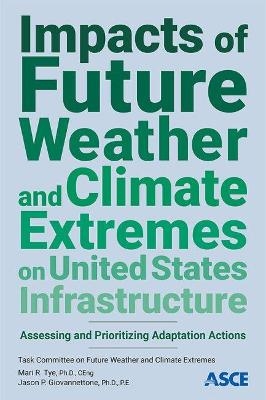
Impacts of Future Weather and Climate Extremes on United States Infrastructure
Assessing and Prioritizing Adaptation Actions
Seiten
2021
American Society of Civil Engineers (Verlag)
978-0-7844-1586-3 (ISBN)
American Society of Civil Engineers (Verlag)
978-0-7844-1586-3 (ISBN)
Summarises the likely changes in various extreme meteorological and hydrological events and assesses the vulnerabilities of infrastructure within critical sectors and their collective interdependencies.
Impacts of Future Weather and Climate Extremes on United States Infrastructure: Assessing and Prioritizing Adaptation Actions summarizes the likely changes in various extreme meteorological and hydrological events and assesses the vulnerabilities of infrastructure within critical sectors and their collective interdependencies. All policy makers and engineers involved in infrastructure planning and design, from the federal level to local stakeholders, will find the summaries of impacts and the suggested prioritization framework as helpful guides in accommodating projected future weather and climate extremes for their locale.
|Impacts of Future Weather and Climate Extremes on United States Infrastructure: Assessing and Prioritizing Adaptation Actions summarizes the likely changes in various extreme meteorological and hydrological events and assesses the vulnerabilities of infrastructure within critical sectors and their collective interdependencies. All policy makers and engineers involved in infrastructure planning and design, from the federal level to local stakeholders, will find the summaries of impacts and the suggested prioritization framework as helpful guides in accommodating projected future weather and climate extremes for their locale.|Prepared by the Task Committee on Future Weather and Climate Extremes of the Committee on Adaptation to a Changing Climate of ASCE
Impacts of Future Weather and Climate Extremes on United States Infrastructure: Assessing and Prioritizing Adaptation Actions summarizes the likely changes in various extreme meteorological and hydrological events and assesses the vulnerabilities of infrastructure within critical sectors and their collective interdependencies. In addition, frameworks that decision makers can use to prioritize limited budgetary resources for adaptation efforts are reviewed.
Critical sectors are aggregated into five overarching infrastructure sectors: energy; transportation, including roads, bridges, rail, transit, and aviation; drinking water and wastewater; water storage and flood protection; and navigation, including ports and harbors. Each sector is reviewed with respect to the potential impacts of climate change pertinent to that sector, current sector fragility or resilience to such impacts, adaptation readiness, and dependency on or contribution to other sectors.
The book continues with a proposed step-by-step prioritization process, which includes several questions that may be considered depending on the context, and examples of case-specific prioritization frameworks used by other organizations. A proposal for necessary future research concludes the publication.
All policy makers and engineers involved in infrastructure planning and design, from the federal level to local stakeholders, will find the summaries of impacts and the suggested prioritization framework as helpful guides in accommodating projected future weather and climate extremes for their locale.
Impacts of Future Weather and Climate Extremes on United States Infrastructure: Assessing and Prioritizing Adaptation Actions summarizes the likely changes in various extreme meteorological and hydrological events and assesses the vulnerabilities of infrastructure within critical sectors and their collective interdependencies. All policy makers and engineers involved in infrastructure planning and design, from the federal level to local stakeholders, will find the summaries of impacts and the suggested prioritization framework as helpful guides in accommodating projected future weather and climate extremes for their locale.
|Impacts of Future Weather and Climate Extremes on United States Infrastructure: Assessing and Prioritizing Adaptation Actions summarizes the likely changes in various extreme meteorological and hydrological events and assesses the vulnerabilities of infrastructure within critical sectors and their collective interdependencies. All policy makers and engineers involved in infrastructure planning and design, from the federal level to local stakeholders, will find the summaries of impacts and the suggested prioritization framework as helpful guides in accommodating projected future weather and climate extremes for their locale.|Prepared by the Task Committee on Future Weather and Climate Extremes of the Committee on Adaptation to a Changing Climate of ASCE
Impacts of Future Weather and Climate Extremes on United States Infrastructure: Assessing and Prioritizing Adaptation Actions summarizes the likely changes in various extreme meteorological and hydrological events and assesses the vulnerabilities of infrastructure within critical sectors and their collective interdependencies. In addition, frameworks that decision makers can use to prioritize limited budgetary resources for adaptation efforts are reviewed.
Critical sectors are aggregated into five overarching infrastructure sectors: energy; transportation, including roads, bridges, rail, transit, and aviation; drinking water and wastewater; water storage and flood protection; and navigation, including ports and harbors. Each sector is reviewed with respect to the potential impacts of climate change pertinent to that sector, current sector fragility or resilience to such impacts, adaptation readiness, and dependency on or contribution to other sectors.
The book continues with a proposed step-by-step prioritization process, which includes several questions that may be considered depending on the context, and examples of case-specific prioritization frameworks used by other organizations. A proposal for necessary future research concludes the publication.
All policy makers and engineers involved in infrastructure planning and design, from the federal level to local stakeholders, will find the summaries of impacts and the suggested prioritization framework as helpful guides in accommodating projected future weather and climate extremes for their locale.
| Erscheinungsdatum | 01.10.2021 |
|---|---|
| Co-Autor | Amir AghaKouchak, R. Edward Beighley, William J. Capehart |
| Verlagsort | Reston |
| Sprache | englisch |
| Maße | 152 x 229 mm |
| Gewicht | 255 g |
| Themenwelt | Naturwissenschaften ► Geowissenschaften ► Meteorologie / Klimatologie |
| Technik ► Bauwesen | |
| ISBN-10 | 0-7844-1586-2 / 0784415862 |
| ISBN-13 | 978-0-7844-1586-3 / 9780784415863 |
| Zustand | Neuware |
| Haben Sie eine Frage zum Produkt? |
Mehr entdecken
aus dem Bereich
aus dem Bereich
Grundlagen – Maßnahmen – Planungen
Buch | Hardcover (2021)
Springer Fachmedien Wiesbaden GmbH (Verlag)
149,99 €
das Wolkenbuch für alle
Buch | Softcover (2024)
Seifert Verlag
20,00 €
A User Guide for Offshore Renewables and Oil & Gas
Buch | Hardcover (2024)
Whittles Publishing (Verlag)
56,10 €


